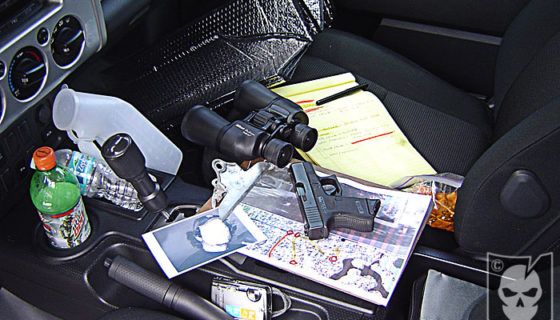PSD Concepts: Introduction and Daily Routes
PSD Concepts: Introduction and Daily Routes
- PSD Concepts: Introduction and Daily Routes
- PSD Concepts: How to Detect Surveillance and Counter
- PSD Concepts: Attack Recognition and the Art of the Ambush
- PSD Concepts: Why You Should Conduct Vehicle Searches
In the following new series of articles on ITS Tactical we’ll talk about how you can apply concepts and tactics used by Personal Security Detail (PSD) teams into your daily life. Military, contractor, and private security details use these methods to move officials and VIPs safely throughout the world.
While most of the movements and tactics are very complex and require extensive training and experience, the average person can learn the basics to help protect themselves and their families.
The likelihood of you being attacked by a well trained group of terrorists is pretty unlikely. You may, however, end up as a target of opportunity for a local criminal or group of criminals. You may drive a nice car, own a nice house, or just end up a victim by being at the wrong place at the wrong time.
Whatever the situation, there are things you can do on a daily basis that could prevent you from becoming a victim in the first place. You’re already at a disadvantage since you probably don’t have any intelligence on who may want to do you harm. This is where you need to be creative and think to yourself; if I were going to attack “me,” how would I do it?
Route Surveys
I want to start with vehicle route surveys and show how you can apply them to your daily travels. We’re going to focus on your residence and work (or school), as they are the two locations you have to be at on a consistent basis. You can (and should) also use these tactics when you travel somewhere new. Once you’re familiar with route surveys you’ll be able to incorporate counter surveillance techniques and other tactics to maintain a good overall security posture when you travel.
Let’s face it, it’s impossible to be alert 100% of the time. Think about your drive today. Can you recall what you were doing when you left and returned home? Who or what vehicles were near your residence or at the first choke point in your route? A good route survey can help you predict when or where you are more likely to be attacked. This will help you plan how you will escape or defend these areas if the need ever arises.
Map Reconnaissance
The first step is to conduct a map reconnaissance. I know you’re saying to yourself, I have driven this route a thousand times and I know how to get to work and back. When I worked as a Patrol Deputy I was always amazed when we’d have to shut down a roadway. Some residents would say that using this road was the only way they knew how to get home. It was like rubbing your hand across an ant trail; they would flip out and not have a clue where to go. If you’re reading this and found your way to ITS Tactical I won’t presume that you’re in this group, however having a map to help plan your routes is an essential tool.
- Gather your maps and resources. Since we are focused on going from home to work and back, I won’t go into the different types of maps that you would use if you were overseas. There are several variables that you won’t have to worry about here. In this case a simple road map or Google Maps search will suffice.
- Review your maps and look at the route you normally take from home to work. You may have two different routes already as some roads are faster going to work but congested coming home. Look to find several routes based on the information below.
- The key is to vary your routes so that you won’t be predictable. Don’t make this overly complicated by stitching your route down every back road. Stick to the main roads when they are more realistic.
- Note all safe havens like police departments, police sub stations, or fire stations; any location you could escape to, to get help or medical attention. Looking at your map you may be surprised to find some safe havens near your routes that you never knew about.
- Find potential hazards along your routes. This is more critical when you travel somewhere new, as you don’t know the area. At home you know the areas to stay out of, but you need to identify them so that one of your new routes doesn’t end up running right through the bad part of town. These also include bridges, tunnels, road construction, or other road hazards.
- Looking at your potential routes you will find locations and intersections that are common to all your routes, no matter how you switch them up. These are called “choke points.” They’re the predictable locations that you unavoidably have to pass through. The road in front of your home and work are the two most common choke points. When you look at your mapped routes you may be surprised to find many more locations that you can’t avoid.
Drive the Routes
When you’ve completed your map reconnaissance, it’s time to drive the selected routes.
- Reconfirm the information you gathered. Google Maps may not have that new fire station that was just built or that new road project.
- Since we are talking about home to work and back, it’s important to do this at the times you would normally travel. You also have to be realistic and not add an hour to your commute time.
- Look at the safe havens you found on your map. They may not be as good as you thought once you view them from the road. You may also find more suitable locations during your drive.
- Identify your hazards, such as road construction and detours. These may not be potential attack sites but they could affect your safety. These are separate from your choke points. Also think about areas that might be a nice soft target for criminals or terrorists. Do you have to drive by that location or can you bypass it?
Analyze Attack Sites and Choke Points
Now that you have your routes laid out, it’s time to look at and analyze possible attack sites and choke points. This is where you have to think like an attacker. As I stated previously, you may have zero intelligence and you may not know the modus operandi of your potential adversary, so it’s important to be creative. Just don’t overcomplicate it by thinking up scenarios like a zombie apocalypse.
- Think like an attacker. Look at the advantages and disadvantages of each attack site on your map.
- Are you predictable? Do you arrive at a certain attack site or choke point routinely?
- Is a certain site an obvious choke point? Does it limit your action or response to an attack? Can you get off the X from this location? If not, how will you defend your position?
- Does the area provide cover or concealment for the attacker(s)? Is there a reason for a certain person or group to be in the area (construction site workers or a group of people at a park)? We will cover more of this later in how to conduct counter surveillance.
- Does the area give the attacker an easy escape route? A common criminal is going to have a quick escape route, whether it’s on foot or in a vehicle.
Mark Each Attack Site
The best site(s) from the attackers’ point of view are going to be the most dangerous for you. These are the areas where you need to be vigilant, so get off the cell phone and keep your head on a swivel. I have my kids help me without them realizing it. In my danger zones I always point out people doing something like walking a dog or jogging. Now when I pass these areas my kids look out the window and point out people also. Kids are great eyes and ears, the more of which you have the better.
Safety
A route survey will help you plan your routes and formulate a response to potential attacks at each location. They should be reevaluated as time goes on. Using your route surveys coupled with counter surveillance techniques will keep you sharp in the areas in which you are most likely to be attacked.
I hope this sheds some light on what steps you can take to help keep you and your family safe. In the next article we will getting more into counter surveillance techniques and also how to check your vehicle for devices such as bombs or bananas in your tail pipe.
Be sure to check out one of our related articles on Protecting Against Home Invasions if you haven’t had a chance to yet.
Editor’s Note: Please join us in welcoming Eric S. as a contributor to ITS Tactical. Eric is former Army with a heavy background in PSD for CENTCOM, previously providing security for Gen. Tommy Franks all over the globe. He’s now a full time Law Enforcement Officer and certified gear junkie. Great to have you contributing brother!











Discussion